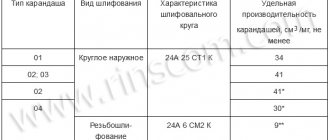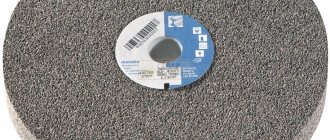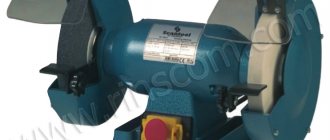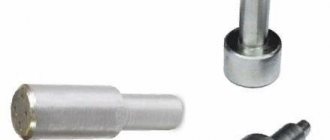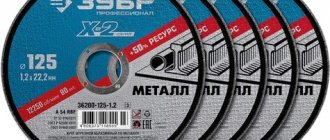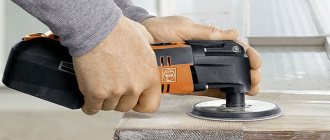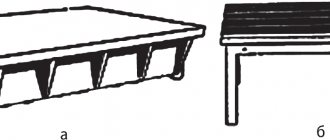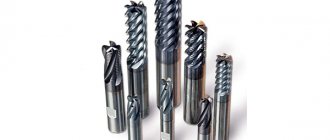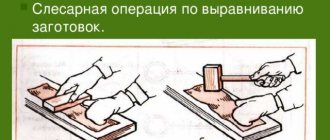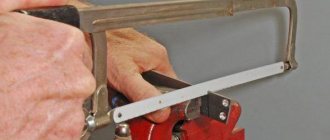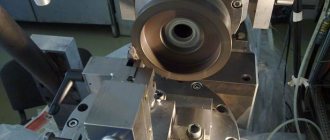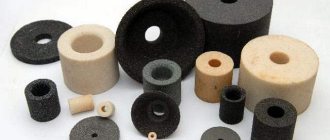Design features and areas of application of diamond grinding wheels
Grinding wheels are consumable diamond tools for manual and automatic grinding machines.
Photo #1: Diamond grinding wheels.
Let's talk about the key design features of the tools. Let's start with the fact that each circle consists of a body and a diamond layer applied to it. In addition to diamonds, it contains a binder with or without filler.
The markings of diamond wheels include two numbers and one letter. These symbols determine the main characteristics of the instruments.
Image #1: Diamond grinding wheel markings
Let's start with the body shape.
Image No. 2: Shapes of diamond wheel bodies
The letter in the marking indicates the cross-sectional shape of the diamond layer.
Image No. 3: cross-sectional shapes of diamond layers
The last number in the marking determines where exactly the diamond-bearing layer is located on the circle.
Image No. 4: options for the location of diamond-bearing layers on diamond wheels
The most important characteristics of diamond wheels also include the type of bond. It can be organic, metallic and galvanic.
Organic bundle
It is a mixture consisting of an organic binder, diamonds and filler.
Image #5: Organic Bundle
The organic binder has low hardness, heat resistance and thermal conductivity. The use of such a tool is characterized by high productivity and a small amount of time spent on processing workpieces.
Let us list the main areas of application of diamond wheels with an organic binder.
- Grinding, sharpening and finishing of parts and products made of hard alloys and superhard materials.
- Processing of high-precision measuring and medical instruments.
- Manufacturing of products from refractory materials.
- Polishing and cutting of precious stones.
Metal bundle
Its composition looks like this.
Image #6: metal bundle
The metal bond is characterized by high hardness, thermal conductivity and heat resistance. Wheels with such diamond-bearing layers are used for:
- performing rough operations that require the removal of large allowances;
- profile grinding;
- sharpening of carbide parts and products;
- processing of workpieces made of special ceramics and other difficult-to-process materials.
Galvanic bond
It is coated with the addition of diamonds on supporting metal bases. In such circles, the grains protrude far beyond the surface of the binder. This makes chip removal much easier.
Image No. 7: galvanic bond
Diamond wheels with a galvanic bond are distinguished by high cutting ability, good thermal conductivity, low cost and the ability to perform any geometry. Let us list the areas of application of tools in this category.
- Processing of parts and products made of silicon, germanium and other semiconductor materials.
- Grinding and cutting workpieces made of sital and various types of technical glass.
- Textured processing of natural and artificial stone.
- Manufacturing of laps and diamond heads of various shapes.
- Production of hand tools for finishing dies made of alloy steels and hard alloys.
Other characteristics of diamond grinding wheels
Let's list the remaining parameters.
- Case size. The choice of tool depends on the dimensions of the workpiece and the operation to be performed.
- Grain. Determines the cleanliness of the surface after treatment. The finer the grain of the wheels, the smoother the surfaces will be. The main disadvantage of fine grain size is that tools often become clogged during work. It is also possible to burn the surface of the workpiece.
- Diamond concentration. This parameter directly depends on the grain size. The higher the grain size, the more diamonds there are in 1 mm3 of the abrasive layer. High concentration wheels are used to treat small areas. Low concentration tools are designed for processing large surfaces.
- Accuracy classes. There are 3 of them - B, A and AA. The latter are the best in quality. With the help of such diamond wheels, high-precision operations are performed.
- Imbalance classes (1–4). Depends on the quality of the abrasive mass.
How does a diamond pencil work?
The diamond ruling pencil has the form of a steel pin 5 cm long. Natural/synthetic diamonds are placed at the bottom of the product. The function of a connecting link is performed by a metal alloy with an expansion coefficient close to that of diamond crystals.
In domestic conditions, tools with a diameter of 80–100 mm are most often used. During operation, it is fixed in special holding devices. For profile grinding and dressing of large diameter wheels, it is rational to buy a diamond pencil with large crystals in the frame. The advantage of large diamonds is the presence of natural edges, which increase the wear resistance of the tool.
Image No. 1: Diagram of the device of diamond pencils types 01, 02, 03, 04 according to GOST
The frame of products comes in various shapes: cylinder, steps, cone. There are diamond pencils with carvings. Diamonds are held inside the product by soldering, chasing, or metal clamps. The pencil should be attached to the holder in such a way that the tool protrudes beyond the edges of the frame by a maximum of ¼ of its length.
Why do you need to edit diamond grinding wheels?
No matter how high-quality diamond grinding wheels are, they sooner or later deteriorate and wear out during use. Happens:
- smoothing in some areas;
- breaks;
- abrasion;
- salting
There are much fewer problems when using soft grinding wheels. They have the property of self-sharpening. As grains fall out, new layers are exposed. Solid instruments do not have this property. To restore the characteristics of such diamond grinding wheels, editing is needed. After it, the instruments get a new life. The cutting properties and geometric shape of products are restored.
Methods for dressing diamond wheels
There are three ways to dress diamond wheels. Let's talk about the technologies used.
Grinding method
Involves the use of high-strength and hard tools. They are used to grind circles in order to destroy the bond and subsequently sharpen the diamonds.
The following devices are used for dressing diamond grinding wheels.
- Diamond needles.
- Rods with large diamond stones at the ends.
- CBN cutters.
- Diamond pencils, etc.
Photo No. 2: devices for dressing diamond grinding wheels using the grinding method
The technology involves simple treatment of the surfaces of a worn circle rotating at a speed of up to 35 m/s. Everything happens either manually or using special tools.
Grinding method
The following categories of tools are suitable for this.
- Diamond rollers.
- Grinding wheels (diamond, CBN).
- Disks made of tungsten carbide alloys.
Dressing diamond wheels using grinding technology has the following features.
- The worn tool is set to a working rotation speed.
- The rotation speed of the straightening device is low. The indicator does not exceed 25 m/min.
- Editing is performed using special equipment.
- The axis of the grinding apparatus can be located either perpendicular or parallel to the axis of rotation of the diamond wheel.
Photo No. 3: machine for dressing diamond grinding wheels
Run-in method
Involves the use of special round tools. These include:
- silicon carbide circles;
- steel discs with cemented and hardened surfaces;
- carbide rollers;
- star balls.
Instruments of the latter category have become the most widely used.
The principle of the technology is that worn discs, upon contact with the device, begin to smoothly slide over the surface of the tool (roll it in). As a result:
- the diamond grains are released;
- a new layer of the working surface is exposed;
- the circle is leveled.
We will tell you in detail about the use of cutters for dressing diamond grinding wheels.
How are diamond pencils used?
Straightening abrasive wheels with a diamond pencil is a high-precision method of restoring the properties of the working surface of a product. The tool allows you to edit the shaped profile and return the original geometry at high speeds. The straightening process involves grinding a brittle material with a denser abrasive.
Image No. 2: Scheme of installing a pencil relative to the sanding wheel being processed
To obtain optimal results, it is recommended to install the tool at an angle of 10-15 degrees in the direction of rotation of the wheel with a slight turn in the direction of feed. This method allows you to periodically rotate the tool along the axis, reducing the load and destruction of the working part of the pencil.
Dressing diamond grinding wheels with cutters: technology and features
Let's start with the fact that the standard cutters most often used for dressing diamond wheels can have blunt and sharp teeth.
Photo No. 4: sharp-toothed (right) and blunt-toothed (left) cutters
Devices of the first type are used for dressing diamond grinding wheels with grains of minimal size. This is due to the fact that a sharp-toothed cutter will only spoil the circle with grains of large and medium fractions. Blunt-toothed devices are suitable for straightening such products. As you might have already guessed, you can’t edit circles with fine grains using blunt-toothed cutters!
Note! To dress diamond grinding wheels, not just one type of cutter is used, but sets of devices. They are fixed in special holders.
Photo No. 5: cutters fixed in a holder
Technology for dressing diamond grinding wheels with cutters
The process of dressing diamond grinding wheels with cutters looks like this.
- A set of devices is assembled into a single block.
- It is secured in a holder.
- The resulting device is installed on a special axis equipped with a handle for the operator.
- The tool is brought into contact with a rotating worn diamond blade.
This grinding wheel dressing technology has its advantages and disadvantages. Let's start with the positives.
- Editing goes very quickly.
- Cutters for dressing diamond wheels are cheap.
- High efficiency of editing is ensured. The working surfaces of the circles are not smoothed.
- The technology is easy to use.
The main disadvantage of the method is the release of a large amount of dust, but the problem is easily solved with the help of an industrial vacuum cleaner.
Rules and features of dressing diamond grinding wheels with cutters
- Wear safety glasses and use a dust mask.
- Do not use cutters that are not the right size for straightening.
- Work the circles above their centers. This will prevent the teeth from excessively deepening into the abrasive surfaces.
- Move the holder with the cutters as smoothly as possible.
- When dressing, try to maintain a steady pressure on the diamond wheel.
- When sparks appear, increase the pressure.
Diamond Pencil Marking
To choose the right tool, pay attention to the markings. Standard product designations are specified in GOST 607-80. The regulations specify parameters such as tool size, varieties, technical requirements, etc.
The following points become mandatory:
- trademark of the company that produced the pencil;
- product designation without the first six digits;
- types of diamonds (01, 02, 03), where the letter A corresponds to natural stones, C - synthetic;
- number according to the manufacturer's marking.
The first five digits in the code are the standard designation of the location of the stones and their weight, which ranges from 0.5–2 carats.
Numbers 0051–0055
Image No. 4: Chain arrangement of natural diamonds
In these products, stones are placed along a chain. The scope of application of pencils is editing medium-density abrasive wheels. Contains natural diamonds.
Diamond weight by numbers:
- 0051–0053 — 0.5 carats;
- 0054 - 1 carat.
Numbers 0081–0085
Image #5: Layered arrangement of natural crystals
The crystals go in layers. The products are used for straightening wheels of maximum hardness. Contains natural diamonds.
Diamond weight by numbers:
- 0081–0083, 0085 — 1 carat;
- 0084 - 2 carats.
Numbers 0086–0088
Image No. 6: Layer-by-layer arrangement of technical stones
Diamonds in products are arranged in layers. The weight of all crystals is 1 carat. The stones are synthetic, suitable for grinding medium-hard wheels with a diameter of up to 600 mm.
